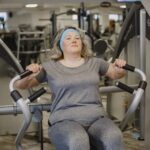How does exercise improve motor fitness, a question that many individuals may have when considering their physical activity routine. Motor fitness plays a crucial role in our daily activities, influencing our coordination, agility, balance, and reaction time.
Understanding the impact of exercise on motor fitness is essential for maintaining overall health and well-being. This article aims to delve into the science behind exercise and its direct impact on motor fitness, as well as explore the benefits of regular physical activity in improving these essential components of physical function.
Motor fitness encompasses a range of skills that are vital for performing everyday tasks with ease and efficiency. From the simple act of walking to more complex movements such as playing sports or operating machinery, motor fitness directly impacts our ability to navigate through life comfortably. Whether it’s maintaining balance while walking on an uneven surface or reacting quickly to avoid a potential hazard, these skills are key in preventing injury and maintaining independence.
Regular exercise has been shown to have a significant impact on improving motor fitness. By engaging in different types of physical activities such as strength training, cardio, and flexibility exercises, individuals can target specific components of motor fitness and see noticeable improvements over time. The physiological changes that occur in the body during exercise directly contribute to enhancing coordination, agility, balance, and reaction time – all essential elements of motor fitness that can be honed through consistent physical activity.
Understanding Motor Fitness
Motor fitness is an essential component of overall physical fitness that directly impacts an individual’s ability to perform daily activities with ease. It encompasses various components such as coordination, agility, balance, and reaction time.
Coordination involves the ability to use different parts of the body together smoothly and efficiently, while agility refers to the ability to change direction quickly and control body movements effectively. Balance is crucial for maintaining stability and preventing falls, and reaction time is important for responding quickly to stimuli or changes in the environment.
Coordination
Coordination plays a vital role in activities such as walking, running, dancing, and playing sports. It requires a combination of muscle actions that are well-timed and precise, involving both fine motor skills (such as writing) and gross motor skills (such as throwing a ball).
Agility
Agility is particularly important for activities that involve dynamic movements and quick directional changes, such as basketball, soccer, or martial arts. It also contributes to everyday tasks like navigating through a crowded space or avoiding obstacles while walking.
Balance
Balance is essential for maintaining stability while standing or moving. Good balance not only prevents falls but also enhances the performance of activities like yoga, Pilates, or even simple tasks like bending over to tie shoelaces.
Reaction Time
Reaction time measures how quickly an individual can respond to a stimulus or signal. It is crucial for activities that require quick decision-making and responses, such as driving or playing racket sports.
The Science Behind Exercise and Motor Fitness
Regular exercise has a significant impact on motor fitness, and understanding the physiological changes that occur in the body during physical activity can provide insight into this connection. When engaging in exercise, the body undergoes various processes that directly impact motor fitness. These include:
- Increased blood flow to the muscles: During exercise, the heart pumps more blood to the muscles, delivering essential nutrients and oxygen. This improved circulation aids in developing strength, coordination, and agility.
- Activation of neuromuscular pathways: Exercise stimulates the nervous system, which in turn enhances communication between the brain and muscles. This activation leads to improved reaction time and coordination.
- Release of endorphins: Physical activity triggers the release of endorphins, also known as “feel-good” hormones. These chemicals not only elevate mood but also contribute to improved balance and overall motor function.
Moreover, regular exercise promotes neuroplasticity, which is the brain’s ability to adapt and rewire itself in response to new experiences or changes in the environment. This means that participating in physical activities can lead to structural changes in the brain that support better motor coordination, balance, and agility.
Understanding these physiological changes underscores the direct relationship between exercise and motor fitness. By engaging in regular physical activity, individuals can effectively enhance their overall motor abilities and improve their performance in daily activities that require coordination, balance, agility, and reaction time.
Types of Exercises for Motor Fitness
In order to improve motor fitness, it is essential to engage in various types of exercises that specifically target different components of motor fitness such as coordination, agility, balance, and reaction time. Here are some types of exercises that can help improve motor fitness:
- Strength training: This type of exercise focuses on building muscle strength and enhancing overall body mechanics. It often involves using resistance or weights to challenge the muscles, leading to improved coordination and balance.
- Cardiovascular exercises: Activities such as running, swimming, dancing, or cycling are excellent for targeting cardiovascular endurance and agility. These exercises also help enhance reaction time by requiring quick and coordinated movements.
- Flexibility exercises: Stretching and flexibility-focused exercises like yoga or Pilates are crucial for improving overall balance and mobility. By increasing flexibility, individuals can also enhance their coordination skills.
It is important to integrate a combination of these exercise types into a well-rounded workout routine in order to maximize the improvement of motor fitness.
Regular participation in these exercises will not only lead to physical changes in muscle strength and endurance but they also affect neuro-muscular pathways in the brain that contribute to enhanced motor skills. By engaging in these different types of exercise, individuals can expect noticeable improvements in coordination, agility, balance, and reaction time over time.
Benefits of Exercise on Motor Fitness
Physical exercise has been proven to have numerous benefits on motor fitness, including increased coordination, improved balance, and enhanced reaction time. These improvements are essential for daily activities and sports performance. Through regular exercise, individuals can significantly enhance their motor fitness, leading to a better quality of life.
Increased Coordination
Coordination is the ability to execute smooth and accurate movements through proper muscle control. Regular exercise, especially activities that involve both upper and lower body movements such as dancing or martial arts, can greatly improve coordination. By practicing these exercises consistently, individuals develop a better sense of body awareness and control, leading to increased coordination.
Improved Balance
Balance plays a crucial role in daily activities and physical performance. Exercises that focus on stability and core strength, such as yoga or Pilates, are highly effective in improving balance. These exercises help strengthen the muscles that support posture and stability while enhancing the body’s overall equilibrium.
Enhanced Reaction Time
Reaction time is the ability to respond quickly to a stimulus. Exercise has been shown to improve reaction time by increasing neural pathways and communication between the brain and muscles. Activities like agility drills, sprinting, or playing sports that require quick decision-making can significantly enhance an individual’s reaction time over time.
Exercise and Cognitive Function
Regular exercise does not only have a positive impact on physical health but also on cognitive function. Studies have shown that engaging in physical activity can enhance cognitive abilities such as memory, attention, and processing speed. The relationship between exercise and cognitive function is vital in understanding how it indirectly influences motor fitness.
One of the key ways in which exercise improves cognitive function is through increased blood flow to the brain. Physical activity stimulates the production of new blood vessels in the brain, which in turn improves overall brain function. Additionally, exercise also promotes the release of neurotransmitters such as dopamine and serotonin, which are essential for cognitive performance.
Furthermore, regular physical activity has been found to reduce the risk of neurodegenerative diseases such as dementia and Alzheimer’s. This is particularly important as these conditions can significantly impact motor fitness due to decreased coordination, balance issues, and slower reaction times. By maintaining good cognitive function through exercise, individuals are better able to preserve their motor fitness as they age.
| Benefits of Exercise on Cognitive Function | Impact on Motor Fitness |
|---|---|
| Enhances memory and learning abilities | Improves coordination and reaction time |
| Boosts attention span and concentration | Enhances agility and balance |
| Reduces risk of neurodegenerative diseases | Preserves overall motor fitness as individuals age |
It is evident that there is a strong connection between exercise, cognitive function, and motor fitness. Therefore, incorporating various forms of physical activity that challenge both the body and mind can lead to significant improvements in overall motor fitness. By doing so, individuals can enjoy enhanced coordination, agility, balance, reaction time while also benefiting from improved cognitive abilities.
Tips for Improving Motor Fitness Through Exercise
Regular exercise plays a crucial role in improving motor fitness, which encompasses coordination, agility, balance, and reaction time. To effectively enhance motor fitness through exercise, it is important to incorporate a variety of workouts that target these specific components. Strength training exercises can help improve coordination and balance, while agility drills can enhance reaction time and overall motor skills. Additionally, flexibility exercises such as yoga or Pilates can contribute to better balance and coordination.
Incorporating a consistent exercise routine into daily life is essential for improving motor fitness. This can be achieved by setting specific goals and creating a structured workout plan that includes diverse exercises targeting different aspects of motor fitness. For example, alternating between strength training sessions and cardio workouts throughout the week can provide a well-rounded approach to improving motor fitness.
Another practical tip for enhancing motor fitness through exercise is to focus on proper form and technique during workouts. This not only prevents injuries but also ensures that the targeted muscle groups are being effectively engaged, thus contributing to improved motor skills. It is also important to gradually progress in intensity and difficulty of exercises to continually challenge the body and stimulate improvements in motor fitness.
| Motor Fitness Exercise Tip | Description |
|---|---|
| Variety of Workouts | Incorporate diverse exercises targeting coordination, agility, balance, and reaction time |
| Consistent Routine | Create a structured workout plan with specific goals for regular exercise |
| Focus on Technique | Prioritize proper form and gradual progression in intensity of exercises |
Real-Life Examples
In conclusion, the evidence overwhelmingly supports the notion that exercise plays a crucial role in improving motor fitness. Through various types of exercises such as strength training, cardio, and flexibility exercises, individuals can enhance their coordination, agility, balance, and reaction time. Furthermore, the physiological changes that occur in the body during exercise directly impact motor fitness, highlighting the interconnectedness between physical activity and motor skills.
Real-life examples serve as powerful testimonials to the positive impact of regular exercise on motor fitness. Individuals who have incorporated exercise into their daily routine have reported increased coordination, improved balance, and enhanced reaction time.
These improvements have translated into better performance in daily activities such as walking, climbing stairs, driving, and participating in sports or recreational activities. The success stories of these individuals underscore the transformative effect of exercise on motor fitness and its ability to significantly improve overall quality of life.
With an understanding of the science behind exercise and its benefits on motor fitness, it is clear that incorporating physical activity into one’s lifestyle is essential for maintaining and enhancing motor skills. By prioritizing regular exercise and adopting a variety of workout routines that target different aspects of motor fitness, individuals can experience tangible improvements in their coordination, agility, balance, and reaction time.
In doing so, they can ultimately lead more active and independent lives while reducing their risk for injury related to impaired motor skills.
Frequently Asked Questions
How Does Exercise Improve Motor Skills?
Exercise improves motor skills by promoting the development of coordination, balance, and strength in the muscles and joints. When we engage in physical activity, our brain sends signals to our muscles to move in specific ways, which requires precision and control. Over time, regular exercise can lead to improved motor skills through the refinement of these movements.
What Motor Fitness Is Enhanced by Exercise?
Motor fitness enhanced by exercise includes agility, flexibility, and reaction time. Agility is the ability to move quickly and easily, which can be developed through exercises that require changes in direction or speed.
Flexibility is improved through stretching and mobility exercises, allowing for a greater range of motion in the joints. Reaction time can be enhanced with activities that challenge the body to respond quickly to stimuli, such as sports or dance.
How Can I Improve My Motor Fitness?
To improve motor fitness, it’s important to incorporate a variety of exercises into your fitness routine. This can include activities that focus on improving balance (e.g., yoga), coordination (e.g., dance), and strength training for muscle development.
Additionally, incorporating activities that require quick reactions and decision-making (e.g., playing sports or doing interval training) can help enhance overall motor fitness. Consistency is key, so regularly engaging in these types of exercises will lead to noticeable improvements over time.

Passionate about providing useful information to anyone with an interest in the field of Personal Training, I strive to pass on to our readers quality information and to answer any questions about Personal Trainers, the work they do and how to become one.





